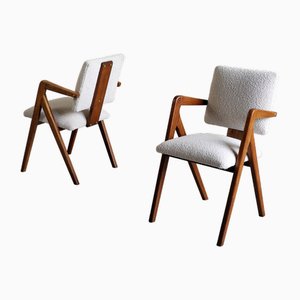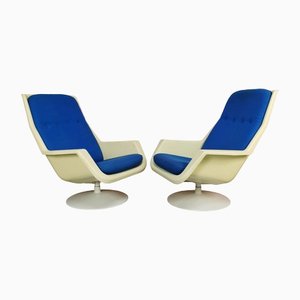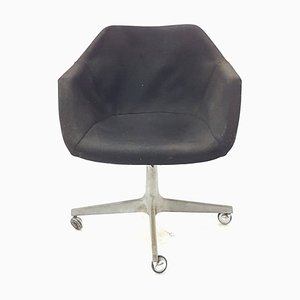
Husband-and-wife designers Robin (1915-2010) and Lucienne Day (1917-2010) were Britain's leading pioneers of modernist design in the 20th century. They played an instrumental role in persuading postwar British society to welcome minimalist, progressive, mass-produced designs into domestic settings.
Lucienne Conradi met Robin Day in 1940 while they were studying design at London's Royal College of Art; the pair married two years later. For over 50 years, they worked side-by-side from their home-studio in Chelsea. They both held teaching positions in the early years of their careers.
Robin Day first came to prominence as a furniture designer in 1948, when his multipurpose storage unit (co-designed by Clive Latimer) won first prize in New York's Museum of Modern Art International Low-Cost Furniture Competition. In 1949, Robin's passion for combining functionalist aesthetics with the latest technology drew the attention of Hille, a small British cabinetmaking firm that aimed to expand into the modern furniture market. Though Robin was never officially employed by Hille—preferring instead to remain a consultant—he effectively worked as the company's head of design for over two decades.
Lucienne Day specialized in textile and wallpaper design that was inspired by the biomorphic forms of modern artists like Wassily Kandinsky and Joan Miró, as well as the evolving landscape of postwar society. She was regularly worked for major retailers, like Stevenson & Son, Mark & Spencer, Cavenidish Textiles, Edinburgh Weavers, and Heals Fabrics.
The Days became London's most famous designers in 1951, following their participation in the landmark Festival of Britain. Robin created a range of plywood and steel-rod chairs for public spaces throughout the festival, and both Days contributed to the festival's Home & Gardens Pavilion. Robin's designs were hailed as "revolutionary," and Lucienne's Calyx Textile, among others, went on to win a number of award and to become a bestseller for Heals. The Day's successful designs for the Festival of Britain were exhibited to great acclaim later the same year at the IX Triennale in Milan.
Many of Robin's designs have attained iconic status, including the Hillestak Chair (1951), 675 Chair (1952), Stak Chair (1954), Gatwick Seating (1958), Polypropylene Stacking Chair (1963), and Forum Armchair (1964)—all for Hille. Robin also designed a number of televisions and radios for Pye.
Since its introduction, Robin's design for super-low cost Polyprop has never been altered, nor gone out of production. Winning the Council of Industrial Design award upon its debut, it's been widely used in offices, waiting rooms, airports, hospitals, schools, and homes around the world. In 2009, it was printed on a Royal Mail postage stamp as part of a series celebrating “British Design Classics."
Lucienne was awarded the International Design Award of the American Institute of Decorators in 1952 and the Gran Premio prize at the Milan Triennale two years later. Lucienne's standout designs include Provence Wallpaper for John Line & Son (1951), Trio Furniture Fabric for Heal (1954), Dandelion Clocks Furnishing Fabric for Heal (1953), HC 6239 Dress Fabric for Cavendish Textiles (ca. 1954), and Apex Furnishing Fabric for Heal (1967). She also designed modern porcelain tableware patterns for Rosenthal, such as Ilias (1962).
Unwaveringly committed to design that enhances people’s lives, Robin and Lucienne Day enjoyed long,distinct yet harmonious careers.Their work can be found in permanent collections of the most famous museums of modern art and design, including the Centre Pompidou in Paris and the Victoria & Albert Museum in London.
The Days both died 2010; Robin at 95 years old and Lucienne Day at 93.





